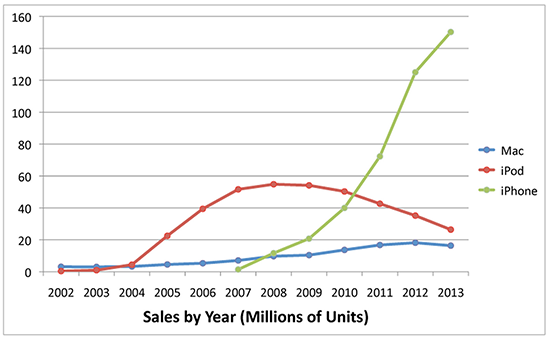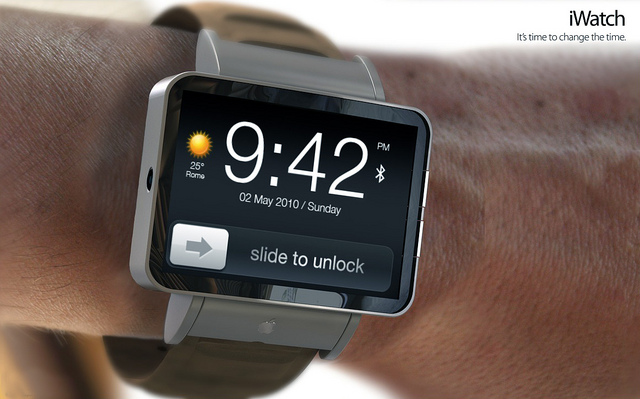 Figure 1 — Apple Device Sales
Now the iPhone has a loyal following but a small share of the smartphone market. Will Tim Cook limit the Apple Watch’s success to iPhone owners, or will Cook free it to dominate the potentially larger wearable devices space?
Freeing the Watch is a strategic imperative.
History tells us that market-leading technology products like the iPhone inevitably fade. The companies that depend on them must innovate into the succeeding categories or fade as well. Kodak, Polaroid, IBM, DEC, Nokia, Motorola, Blackberry, Intel, Sony, Dell and Microsoft are among those fading or faded companies.
All of those other companies underutilized disruptive advances in information technology for (at best) incremental enhancements to their dominant products. By doing so, they missed out on new killer products, business models and industries that coalesced around the new platforms enabled by those technology advances.
Thus, Kodak wasted decades trying to deploy digital photography (which it invented) as an enhancer to its dominant film-driven businesses. Microsoft was slow to the web and the cloud and killed its early e-reader and tablet devices because of internecine struggles over how those new categories related to its Windows and Office businesses. The list goes on: IBM did not lead in minicomputers. DEC and every other leading minicomputer maker missed out on personal computers. Motorola and Nokia were killed by smartphones, and Blackberry is near death.
Limiting the Watch to a peripheral role in the iPhone-centric ecosystem would repeat the same mistake made by those earlier market-leading technology companies.
That’s not to say there is not a lot of money to be made in the defend-the-cash-cow approach. Just look at the more than $650 billion in revenue and nearly $250 billion in earnings that Steve Ballmer delivered in his tenure as Microsoft CEO. Ballmer achieved those impressive numbers by defending and milking Microsoft’s dominant Office and Windows products. Ballmer, Microsoft and its investors missed out, however, on the market value created by Google, Apple, Facebook, Twitter and others that capitalized on search, big data, cloud computing, mobile devices and social media. Ballmer’s inability to grow beyond the core products that he inherited stagnated Microsoft’s market value for a decade.
Likewise, Tim Cook could nurse Apple’s iPhone-driven revenue stream for a long time. I doubt, however, that Tim Cook would be satisfied with a value-creation legacy comparable to Steve Ballmer’s.
It is too early to dismiss the Apple Watch’s potential to transcend the iPhone. We’ll get a measure of Apple’s foresight when it releases the software development kit (SDK) for the Watch. That will show how fundamentally tethered the Watch is to the iPhone and whether Apple has laid the groundwork for the Watch to be standalone at some point.
The real gut check for Tim Cook is further out in time, when technology and creativity enables wearable devices like the Watch to not only stand alone from the iPhone but also to replace it.
Will Tim Cook allow the Watch to cannibalize iPhone sales—as Apple previously allowed the iPhone to eat away at the iPod and risked the iPad's doing the same to the Mac? Or will Apple stagnate as competitors and new entrants out-innovate it? Will Apple fade away as the riches from new killer apps, devices, ecosystems and business models that coalesce around emerging wearables-centric platforms flow to others?
Figure 1 — Apple Device Sales
Now the iPhone has a loyal following but a small share of the smartphone market. Will Tim Cook limit the Apple Watch’s success to iPhone owners, or will Cook free it to dominate the potentially larger wearable devices space?
Freeing the Watch is a strategic imperative.
History tells us that market-leading technology products like the iPhone inevitably fade. The companies that depend on them must innovate into the succeeding categories or fade as well. Kodak, Polaroid, IBM, DEC, Nokia, Motorola, Blackberry, Intel, Sony, Dell and Microsoft are among those fading or faded companies.
All of those other companies underutilized disruptive advances in information technology for (at best) incremental enhancements to their dominant products. By doing so, they missed out on new killer products, business models and industries that coalesced around the new platforms enabled by those technology advances.
Thus, Kodak wasted decades trying to deploy digital photography (which it invented) as an enhancer to its dominant film-driven businesses. Microsoft was slow to the web and the cloud and killed its early e-reader and tablet devices because of internecine struggles over how those new categories related to its Windows and Office businesses. The list goes on: IBM did not lead in minicomputers. DEC and every other leading minicomputer maker missed out on personal computers. Motorola and Nokia were killed by smartphones, and Blackberry is near death.
Limiting the Watch to a peripheral role in the iPhone-centric ecosystem would repeat the same mistake made by those earlier market-leading technology companies.
That’s not to say there is not a lot of money to be made in the defend-the-cash-cow approach. Just look at the more than $650 billion in revenue and nearly $250 billion in earnings that Steve Ballmer delivered in his tenure as Microsoft CEO. Ballmer achieved those impressive numbers by defending and milking Microsoft’s dominant Office and Windows products. Ballmer, Microsoft and its investors missed out, however, on the market value created by Google, Apple, Facebook, Twitter and others that capitalized on search, big data, cloud computing, mobile devices and social media. Ballmer’s inability to grow beyond the core products that he inherited stagnated Microsoft’s market value for a decade.
Likewise, Tim Cook could nurse Apple’s iPhone-driven revenue stream for a long time. I doubt, however, that Tim Cook would be satisfied with a value-creation legacy comparable to Steve Ballmer’s.
It is too early to dismiss the Apple Watch’s potential to transcend the iPhone. We’ll get a measure of Apple’s foresight when it releases the software development kit (SDK) for the Watch. That will show how fundamentally tethered the Watch is to the iPhone and whether Apple has laid the groundwork for the Watch to be standalone at some point.
The real gut check for Tim Cook is further out in time, when technology and creativity enables wearable devices like the Watch to not only stand alone from the iPhone but also to replace it.
Will Tim Cook allow the Watch to cannibalize iPhone sales—as Apple previously allowed the iPhone to eat away at the iPod and risked the iPad's doing the same to the Mac? Or will Apple stagnate as competitors and new entrants out-innovate it? Will Apple fade away as the riches from new killer apps, devices, ecosystems and business models that coalesce around emerging wearables-centric platforms flow to others?What the Apple Watch Says About Innovation
The watch is designed to bolster the iPhone -- but innovators must be willing to move beyond old products and business models.

 Figure 1 — Apple Device Sales
Now the iPhone has a loyal following but a small share of the smartphone market. Will Tim Cook limit the Apple Watch’s success to iPhone owners, or will Cook free it to dominate the potentially larger wearable devices space?
Freeing the Watch is a strategic imperative.
History tells us that market-leading technology products like the iPhone inevitably fade. The companies that depend on them must innovate into the succeeding categories or fade as well. Kodak, Polaroid, IBM, DEC, Nokia, Motorola, Blackberry, Intel, Sony, Dell and Microsoft are among those fading or faded companies.
All of those other companies underutilized disruptive advances in information technology for (at best) incremental enhancements to their dominant products. By doing so, they missed out on new killer products, business models and industries that coalesced around the new platforms enabled by those technology advances.
Thus, Kodak wasted decades trying to deploy digital photography (which it invented) as an enhancer to its dominant film-driven businesses. Microsoft was slow to the web and the cloud and killed its early e-reader and tablet devices because of internecine struggles over how those new categories related to its Windows and Office businesses. The list goes on: IBM did not lead in minicomputers. DEC and every other leading minicomputer maker missed out on personal computers. Motorola and Nokia were killed by smartphones, and Blackberry is near death.
Limiting the Watch to a peripheral role in the iPhone-centric ecosystem would repeat the same mistake made by those earlier market-leading technology companies.
That’s not to say there is not a lot of money to be made in the defend-the-cash-cow approach. Just look at the more than $650 billion in revenue and nearly $250 billion in earnings that Steve Ballmer delivered in his tenure as Microsoft CEO. Ballmer achieved those impressive numbers by defending and milking Microsoft’s dominant Office and Windows products. Ballmer, Microsoft and its investors missed out, however, on the market value created by Google, Apple, Facebook, Twitter and others that capitalized on search, big data, cloud computing, mobile devices and social media. Ballmer’s inability to grow beyond the core products that he inherited stagnated Microsoft’s market value for a decade.
Likewise, Tim Cook could nurse Apple’s iPhone-driven revenue stream for a long time. I doubt, however, that Tim Cook would be satisfied with a value-creation legacy comparable to Steve Ballmer’s.
It is too early to dismiss the Apple Watch’s potential to transcend the iPhone. We’ll get a measure of Apple’s foresight when it releases the software development kit (SDK) for the Watch. That will show how fundamentally tethered the Watch is to the iPhone and whether Apple has laid the groundwork for the Watch to be standalone at some point.
The real gut check for Tim Cook is further out in time, when technology and creativity enables wearable devices like the Watch to not only stand alone from the iPhone but also to replace it.
Will Tim Cook allow the Watch to cannibalize iPhone sales—as Apple previously allowed the iPhone to eat away at the iPod and risked the iPad's doing the same to the Mac? Or will Apple stagnate as competitors and new entrants out-innovate it? Will Apple fade away as the riches from new killer apps, devices, ecosystems and business models that coalesce around emerging wearables-centric platforms flow to others?
Figure 1 — Apple Device Sales
Now the iPhone has a loyal following but a small share of the smartphone market. Will Tim Cook limit the Apple Watch’s success to iPhone owners, or will Cook free it to dominate the potentially larger wearable devices space?
Freeing the Watch is a strategic imperative.
History tells us that market-leading technology products like the iPhone inevitably fade. The companies that depend on them must innovate into the succeeding categories or fade as well. Kodak, Polaroid, IBM, DEC, Nokia, Motorola, Blackberry, Intel, Sony, Dell and Microsoft are among those fading or faded companies.
All of those other companies underutilized disruptive advances in information technology for (at best) incremental enhancements to their dominant products. By doing so, they missed out on new killer products, business models and industries that coalesced around the new platforms enabled by those technology advances.
Thus, Kodak wasted decades trying to deploy digital photography (which it invented) as an enhancer to its dominant film-driven businesses. Microsoft was slow to the web and the cloud and killed its early e-reader and tablet devices because of internecine struggles over how those new categories related to its Windows and Office businesses. The list goes on: IBM did not lead in minicomputers. DEC and every other leading minicomputer maker missed out on personal computers. Motorola and Nokia were killed by smartphones, and Blackberry is near death.
Limiting the Watch to a peripheral role in the iPhone-centric ecosystem would repeat the same mistake made by those earlier market-leading technology companies.
That’s not to say there is not a lot of money to be made in the defend-the-cash-cow approach. Just look at the more than $650 billion in revenue and nearly $250 billion in earnings that Steve Ballmer delivered in his tenure as Microsoft CEO. Ballmer achieved those impressive numbers by defending and milking Microsoft’s dominant Office and Windows products. Ballmer, Microsoft and its investors missed out, however, on the market value created by Google, Apple, Facebook, Twitter and others that capitalized on search, big data, cloud computing, mobile devices and social media. Ballmer’s inability to grow beyond the core products that he inherited stagnated Microsoft’s market value for a decade.
Likewise, Tim Cook could nurse Apple’s iPhone-driven revenue stream for a long time. I doubt, however, that Tim Cook would be satisfied with a value-creation legacy comparable to Steve Ballmer’s.
It is too early to dismiss the Apple Watch’s potential to transcend the iPhone. We’ll get a measure of Apple’s foresight when it releases the software development kit (SDK) for the Watch. That will show how fundamentally tethered the Watch is to the iPhone and whether Apple has laid the groundwork for the Watch to be standalone at some point.
The real gut check for Tim Cook is further out in time, when technology and creativity enables wearable devices like the Watch to not only stand alone from the iPhone but also to replace it.
Will Tim Cook allow the Watch to cannibalize iPhone sales—as Apple previously allowed the iPhone to eat away at the iPod and risked the iPad's doing the same to the Mac? Or will Apple stagnate as competitors and new entrants out-innovate it? Will Apple fade away as the riches from new killer apps, devices, ecosystems and business models that coalesce around emerging wearables-centric platforms flow to others?






